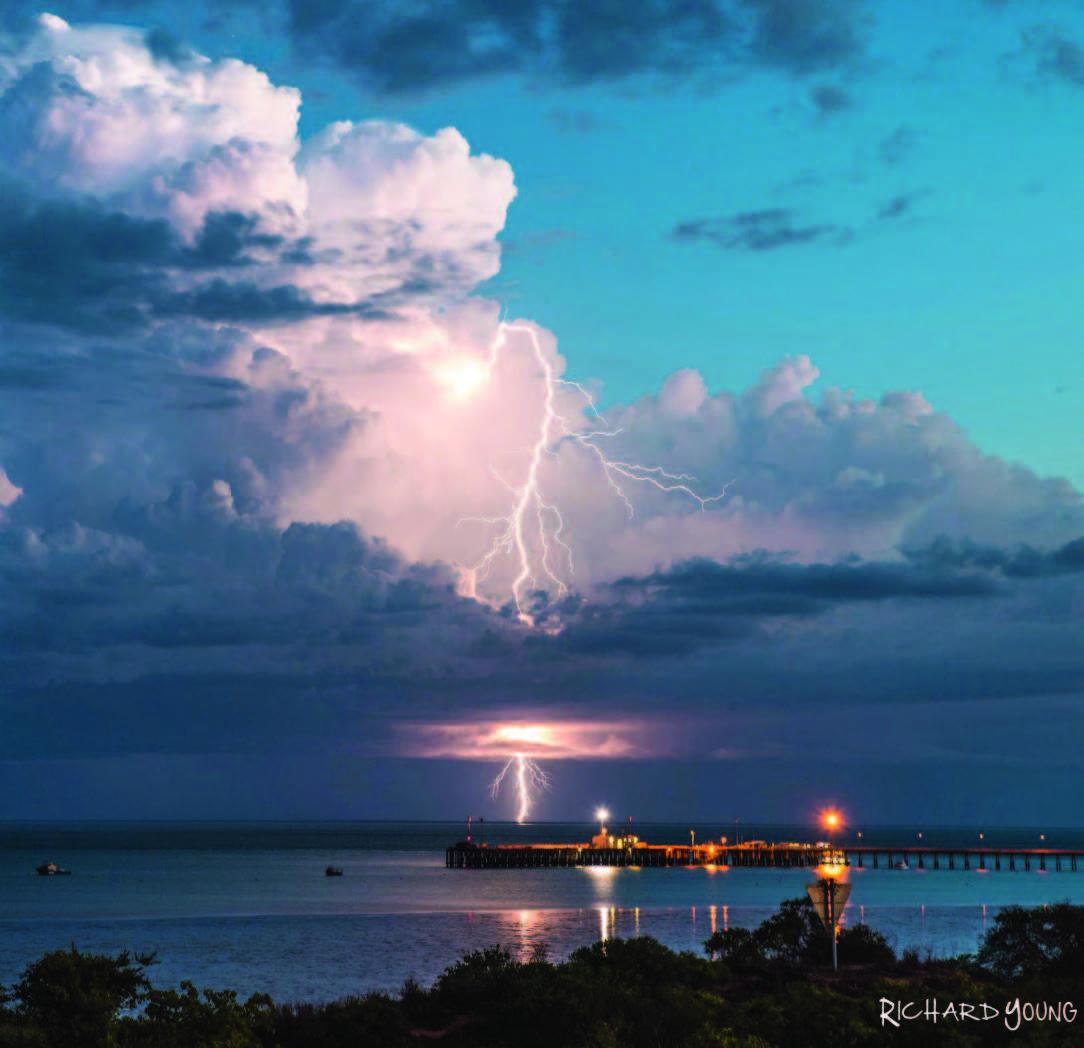2018 - A WET SEASON ADDICTION

Last year, I went to the Mud and Saltwater Film Festival held in Broome. I was fascinated by the images I saw of our Wet Season storms. Most people visit during the Dry and miss out on the electrifying storms of the Wet Season. Richard Young was the photographer, and I was curious to find out more about his unusual passion.
When did you first start photographing storms?
Probably about 11 years ago when digital cameras really took off, I remember the category five Cyclone George off the coast and the swell on Cable Beach was incredible. It started around then’ just seeing the power of nature. Being able to see your image instantly with a digital camera made things so much easier, compared to the slow processing and developing of film in cameras of the past. Instant images, rather than waiting for the photos to come back from a developer.
Was it something from your childhood or was living in Broome that inspired you to pursue photography?
I have always been involved in the outdoors: from snow and rivers earlier, to ocean and coast later in life. I had to watch the weather pretty closely to run my sea kayaking business in Broome. Understanding the weather and wind is pretty crucial every day. I think my first full Wet Season up here was all the inspiration I needed. The addiction was born.
Is Broome a great place to experience and view weather events?
For sure. Sometimes it can take its time to really kick off the season and the town has been known for its anti-storm ‘dome’ where we miss the rain, but once it does start, the skies around Broome are a jaw dropping storm viewing region. There are the most beautiful colours in the Kimberley landscape, making photographing the weather so much more spectacular. The moist Wet Season air streaming in off the coast combining with the rising hot air inland creates the perfect ingredients for storm development. The Kimberley region right through to Darwin in the NT has been rated the highest for lightning strikes anywhere in Australia and the little coastal strip just inland from Broome is up there amongst the best thunderstorm regions in Australia.
You use video as well as photography to record a storm. Is it the perfect photo image that keeps you going, or is there some sort of energy in the storm that draws you in?
Both. A weather system, lightning strike or storm is always unique. It's different each time. You are constantly seeing amazing things and there is always that chance they will do something wild and to capture that moment in time is exciting and very rewarding. Sometimes a video camera captures beautiful footage and other times a camera can capture precise moments of the storm that really highlight the experience and moment in time. It’s a real buzz to see an awesome capture on the screen of your camera. People love the weather and are amazed at seeing events as they unfold, so it’s great to be able to share it with others.
What technology do you used when chasing a storm?
Initially the internet gives you an idea of when the storm may be at its best. Websites such as BOM (Bureau of Meteorology) and Weatherzone showing radar and outlook can be used. It’s crucial to find the best spot and track the movement of the storm. As for camera gear, a digital camera is a must, with a tripod for a steady shot and a wide-angle lens to really fit in the entire storm-scape. Polarising and neutral density filters help darken the shot and increase the chance of capturing a lightning bolt. The good old GoPro is always handy to just hit record and see what it captures as a backup, not to mention a good phone camera to get quick snaps on the run. An understanding of storm development, weather cycles and picking the right day and location helps too. Even with all this technology at hand there are still plenty of days when things don’t go to plan.
‘Storm Chaser’ is that the correct title for what you do?
Storm Chaser….. mmmmm. I kind of like ‘Weather Chaser’ or going on a ‘Weather Adventure’. I guess I am out there chasing storms and the term Storm Chaser has kind of stuck because of this. We all remember those movies like Twister, which was glorified chasing, and whilst it is a fast paced crazy experience, sometimes it’s often the quiet times just watching from a distance that provides a good experience. Occasionally storm chasers can be viewed in a negative way by media and local authorities if they put themselves in danger and are a risk to others when in trouble. Having a good knowledge and healthy respect for what you’re doing out there helps prevent any bad experiences or negative publicity.
Do storms happen mostly in the day or in the night?
Early in the season they seem to happen during the afternoon and have dissipated for a beautiful sunset. As the season progresses, they occur later, and you get those big angry storms raging in across Roebuck Bay with night time lightning and rain. Once the Wet Season really kicks in, they can be at any time of day. Monsoon season gives us line after line of storms. Day time storm photography is mainly based around storm structures and big cloud shot panoramas, then as the light fades into the evening, lightning photography is a focus. It’s quite hard to get good lightning shots during the day.
Do you stay out all night or just go out when the storm is at its peak?
If it’s a known storm day you can plan to be out in place as it first establishes itself, but this can mean sitting out in 42° heat for hours on end. Committing to a big drive inland and just hoping often ends up in failure. Quick chases are often the best. You hear some thunder, look out the window, jump into your car and frantically get to the nearest viewing point, hoping you can set up in time. If it’s close to home, you can even do this a few times in one evening.
Is there a storm chasing group who chat and get together?
There is an Australia wide big weather community made up of people from all walks of life. Weather is the one thing that can bring everyone together. In Broome everyone seems to love the weather and because of this, there is a growing network of people communicating on social media and catching up at local places. It’s a great way to meet others and it's fun.
What safety precautions do you take when you are in a storm?
Being aware of your surroundings; be it in a car on the side of the road or standing on a beach, headland or open area. I have the utmost respect for lightning, strong wind and any other severe weather condition and will not hesitate to retreat to a safe place. Having a healthy respect for weather comes with experience as you know what to expect when it gets nasty. If in doubt, play it safe. The most dangerous part of chasing a storm is the driving, so keeping your eyes on the road and not the sky, watching for cattle and taking care if the road is wet, is vital.
I always wanted to know if you are safe in your car when lightning is all around you. What happens if your car gets struck?
People think that the rubber tyres of the car help to protect you, but that is a myth. A fully-enclosed, all-metal vehicle is very safe place to be. The lightning charge goes around the outside of the vehicle, creating what is called a ‘Faraday Cage effect’ protecting the occupants inside. Just remember to keep windows up and don’t touch any metal parts. It’s a safe haven, even in the scariest of lightning storms. It’s nice to know this.
Where are the best spots for viewing storms in Broome?
It all depends on where the storm is, but being on a peninsula, Broome has a 270° view of our coastline. Places such as Town Beach, Demco Beach, Entrance Point, Gantheaume Point and Cable Beach are just perfect. So many options and it’s only a five minute drive to get to a different point to follow the storm as it moves past. Storms often have different features as they move. As they approach, there are big lightning active shelf clouds, then heavy rain and finally beautiful back end crawler lightning as they move offshore. So much potential for photography; even in one storm.
What else would you like to say to people who might like to get into Storm Chasing?
Firstly, safety is the most important factor for anyone considering storm chasing or even just viewing our weather. Respect lightning, as it can strike 10 to 15 kilometres from the eye of the storm. I have seen this demonstrated in lots of lightning images I have captured. Explore locally around town first, just get in the car and drive out to a viewing area to watch. Enjoy distant storms at any time by just stopping and watching for 10 minutes. Always have a camera or phone handy and when the chance presents itself, capture that unique moment in time and share it with your friends. Concentrate on the road and drive according to the conditions. Retreat to the safety of your car, especially with lighting around. Most of all have fun and play it safe. Enjoy the build-up and the Wet Season as it has so much to offer. It’s great to look forward to the Wet Season each year. When that happens, you know you have acquired the ‘Wet Season addiction’ as well.
You can contact Richard Young via his facebook page https://www.facebook.com/pg/broomeadventure/photos/ and see some of his great storm chasing photos.
